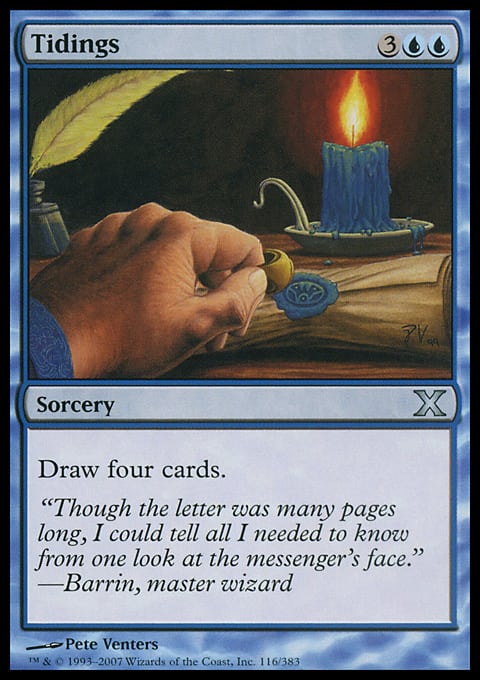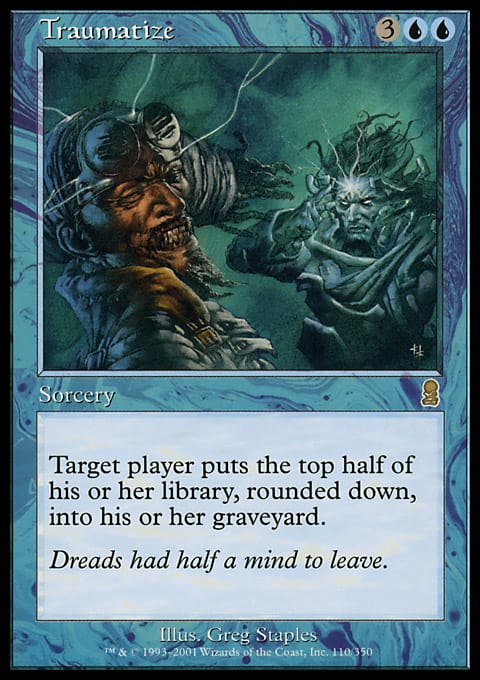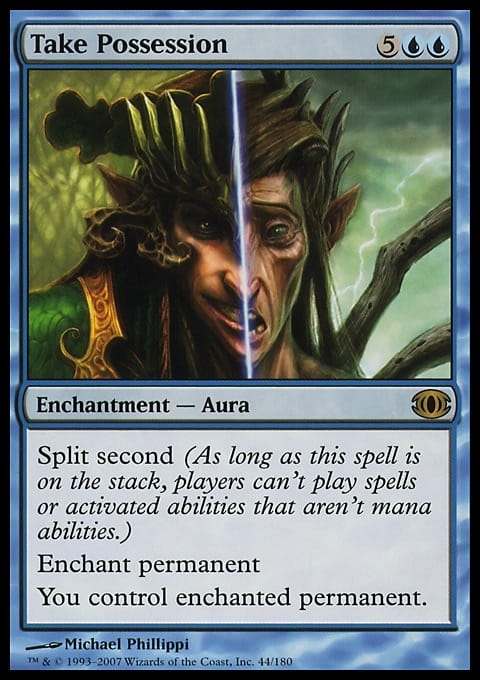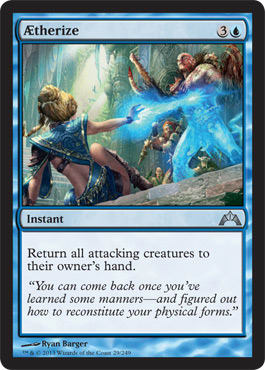Welcome to my new series of articles about multiplayer fare. For each article, I want to look at each color’s strong points and weak points when fighting against multiple opponents. What will get you into the winner’s circle for each color?
We are starting with blue for two major reasons. First, blue changes the most from duels to multiplayer. What works in one setting does not always work in another. Second, blue’s typical mechanics are seriously weakened by multiple opponents. Finally, like all colors, blue has some things that work really well here, so we’ll need to emphasize what works to overcome the difficulties of blue.
In my opinion, the weakest color in multiplayer is red, followed by blue, green, black, and finally the powerhouse of white. Now, don’t confuse these with my favorite colors. These are what I believe are the strongest colors in the format—period. That does not mean that white is my favorite and red my least favorite. My favorite is actually green. But I have to be objective for you and rank them white, black, green, blue, and red for multiplayer. In duels, blue is probably near the front, but some of blue’s mechanics are weakened in the format.
Before we look at multiplayer blue, let’s discuss what blue does.
First, blue loves to draw cards. Sometimes, it does this in raw numbers by playing something like Tidings to draw four cads from one. It can draw cards en masse from Braingeyser, Concentrate, or Deep Analysis. Another way is to look at a few cards and dig for one or two cards. Ponder, Impulse, and Fact or Fiction will dig and nab you some of the cards you looked at. Card-drawing is a key ability of blue.
Another vital mechanic is the counterspell. Blue loves to tap some mana and say “no” to spells. Everything from Cancel to Lost in the Mist says “no.” Blue is happy to trade a few mana and a card to keep you from getting anything nice for Christmas this year. This is an old mechanic that still works, but what happens when someone slips a card past your counter shield? Another classic blue mechanic, bouncing a permanent, comes into play. Just bounce it back to the owner’s hand via something nice, like Repulse, and then counter it the next time it’s played. Bounce and countering handle a large number of permanents.
Sure, you may not have much in the way of creature removal, but you do have creature reallocation, which sends big nasty guys to your side of the table. A simple Mind Control can bring the best creature in play over to your party. You can steal any permanent your foe drops. Combine stealing a permanent with bouncing and countering, and blue can handle a lot of permanents that people believe it has weaknesses against, such as creatures.
Blue used to rule the roof with flying creatures, but with red receiving a powerful flyer virtually every set (Dragon) and white receiving a ton of good flyers, blue now has to settle for Sphinxes and a few other creatures of value, but it sees some really good ones. Key blue flyers combine nice stats with other blue abilities, such as bouncing or card-drawing—Sphinx of Uthuun and Consecrated Sphinx are great examples.
Two other mechanics raise their heads for a quick discussion. If you want to mill some cards from your opponents’ libraries to their graveyards, blue is your best choice. It really wants to win in that area if it can. Mind Sculpt and Traumatize are good examples of that. Also, blue is a color that really likes artifacts, and everything from Tinker to Broodstar can be found in the color. If you want a friend to the artifacts, this is a color you must consider.
Blue has some lesser mechanics, such as islandwalk, defensive creatures, unblockable creatures, tapping stuff, and looting. (Looting is an ability a creature can have that lets it tap to make you draw and discard, such as Merfolk Looter.) Blue is also the trickery color and likes to play with other things, such as changing creature types (Unnatural Selection), color (Prismatic Lace), words on the card (Sleight of Mind), and so forth.
It’s important to look at those things that blue does—now we need to see what happens when we put them in a multiplayer world.
Pretend that I am playing a five-player game tomorrow for casual Magic night. I have a nice table, with four opponents instead of one. So for every turn I take, all of the people opposing me take four turns. They have four attack steps and four draw steps. That’s key to figuring out things, because it means I can be attacked up to four times before I take my next turn, and I am outdrawn four-to-one every single turn.
In this context, what good is Cancel? On turn four, someone plays a Mind's Eye accelerated by a Sakura-Tribe Elder, and I Cancel it. That’s great, and I am stopping one foe from receiving a lot more cards. But it cost me one turn to draw Cancel, and yet, I only stopped one draw out of four of my foes’. Trading my draw step for yours in a duel is great when I’m playing Tidings to draw me more raw cards. What value is it in multiplayer?
Now, there are times when someone will play a card that will throw the game into his or her favor. The player may try to play Martial Coup for fourteen 1/1 tokens when he or she controls In the Web of War. The player will be able to kill people with his or her 3/1 hasted Soldiers. So, you Cancel the spell and move on. Good stuff! But unless you are countering the absolute best, you are going to have a problem. You are running out of counters very quickly if you are constantly countering the best stuff. Many multiplayer decks, especially in Commander, are loaded with lists of Multiplayer’s Biggest Hits. You cannot counter them to keep up. Therefore, I recommend running a small number of high-quality counters for emergencies and not using them unless you absolutely have to have a counter to survive or win. I won’t run a sixty-card deck with more than ten counters, and usually, they are ones such as Spelljack, Dismiss, or Mystic Snake that do things other than just be counters.
Raw card-drawing is still good since you are being outdrawn four-to-one as in our example above. But what value is a Tidings here? I play it and spend one card to draw four, for a net value of plus three cards. That means for that turn, we were at four-to-four. So for the cost of a 5-mana sorcery, I basically reestablished card-advantage equilibrium that happens every turn in a duel (one-to-one). That’s not to say that there is no role for Tidings—I play it a lot—but you need to understand its restrictions. Cards such as Recurring Insight and Mind Spring can come off better in the right circumstances. I skip cards such as Impulse in most of my decks. It’s a waste of space and mana, even if it replaces itself. Unless my deck has a designed need for these cards, such as Sensei's Divining Top and Counterbalance, I’ll stay clear of the smaller stuff.
Stealing is just as good here as it is in duels. You have a higher chance of controlling something quality since there are more people with targets. And if someone ultimately kills your stolen card with a Swords to Plowshares or something, things are still okay—you lost a Dominate for that player’s removal and someone’s creature—you came out ahead two-to-one in the card fight. I prefer Take Possession as a way to steal stuff in multiplayer. You can often take a planeswalker with a lot of counters or a nasty artifact or enchantment with it. Because it takes care of trouble lands, I think Annex is better than many remember it being as well. It’s your way to handle something such as a Maze of Ith.
Flyers are very important in multiplayer. The more flyers you see, the more you need to play them. They are like nuclear weapons—mutually assured destruction if you have them is promised, so everyone sits on their flyers and doesn’t attack anyone save for the person who doesn’t have them. Blue can stand up to the rest but is outclassed by the Angels and Dragons of white and red, respectively, and thus comes in third in the flying arena. Again, you have Consecrated Sphinx, Sphinx of Magosi, and Keiga, the Tide Star as solid entries.
Playing well with artifacts can work in a multiplayer setting quite well. If you build a deck around it, guys such as Master Transmuter, Phyrexian Metamorph, and Master of Etherium join with March of the Machines and Transmute Artifact for an interesting deck concept.
Milling can be a good route to victory when you need to find an alternate path, but in some casual formats, this is easier than others. It’s easier in a format in which my foes have sixty-card decks, for example. Plus, one issue with milling has always been that it does nothing at all until you kill someone—it has no impact on the table.
Bouncing is weaker since you can’t bounce an attacker and expect to go untouched until your next turn. After all, you could be attacked by others very easily. I think bounce is only worth playing if is repeatable (Capsize) or en masse (Aetherize, Evacuation).
Abilities such as shroud, islandwalk, looting, and a few others either are just as good here (unblockable), a bit weaker (looting), or about the same (shroud).
So, the result of this quick little analysis is that blue ends up much worse in multiplayer than it is in duels because mechanics such as countering and bouncing, which are its bread and butter, are weaker. It has to work harder to make raw card-drawing matter, whereas sifting for a card a la Impulse or Preordain is weaker because just going one-to-one with your card and mana when already down four-to-one or three-to-one or sixt-to-one is not a great play. You are only third-best in flying creatures, and some abilities such as tapping and looting don’t translate very well to multiplayer.
This is why blue tumbles to fourth on my list of multiplayer power. But don’t worry—blue can still pull it out.
We need to emphasize its strengths.
Strength #1: Stealing – This is where you must put serious emphasis. In addition to stealing via permanents, look at Acquire and Bribery. Frankly, I’d also consider Knowledge Exploitation. These are great ways to grab something very valuable from an opponent’s deck and put it right out onto the table. Use stealing for your countermagic, such as Spelljack, Desertion, and Commandeer. I talked already about Take Possession, Annex, and Dominate—all of which have value. Even if it’s technically an artifact, Vedalken Shackles is also keenly important. At the end of the day, this is the strongest blue mechanic in multiplayer, so emphasize it.
Strength #2: Raw Card-Drawing – Sure, you have to jump through a few low-level hoops in order to make this stick, but once you do, you’ll find yourself outdrawing others. Not only do you have a lot of spells, such as the aforementioned Recurring Insight and others, but you should add card-drawing to everything. Card-drawing on creatures? We’ve mentioned a lot of Sphinxes that do that already. Card-drawing on spells? Go with Dismiss, Repulse, Exclude, and Overwhelming Intellect. Do what you already want to do, but with cards! Also, don’t ignore permanents such as Thought Reflection, the various Jace planeswalkers that draw you cards, and more.
Strength #3: Sneaky Attackers – Combat at a multiplayer table can often be a bit complex with all of these potential blocking and attacking scenarios, and as a result, people don’t always attack. When you have a cluttered board, using blue is among the best ways to push a hit in with an unblockable creature. My favorite is Deep-Sea Kraken because of the suspend on it. People often don’t want to play into it, so they slow down their spellcasting, but if not, you can get in with it for one or two goes around the table. Having a few of these unblockable creatures will help.
Strength #4: Defensive Creatures – Blue has a good number of defensive-minded creatures that can help them stay alive. Now, it’s a distant second fiddle to white, who rules this category from way up on high, but blue comes in second place here. It has things such as recent options of Hover Barrier and Fog Bank all the way back to Wall of Air. You can play a ton of high-toughness creatures that can swing, such as Tradewind Rider and Meloku the Clouded Mirror.
In addition to these four strengths, blue will need good-quality flyers to last in the skies, repeatable or mass bounce if you want that at all, and more.
When you combine these strengths to some of blue’s best multiplayer cards—Propaganda, Reins of Power, Teferi, Mage of Zhalfir, Future Sight, Leyline of Anticipation, and so on—the result is a deck and a color that can win at the multiplayer table.
So do it!
See you next week,
Abe Sargent



























